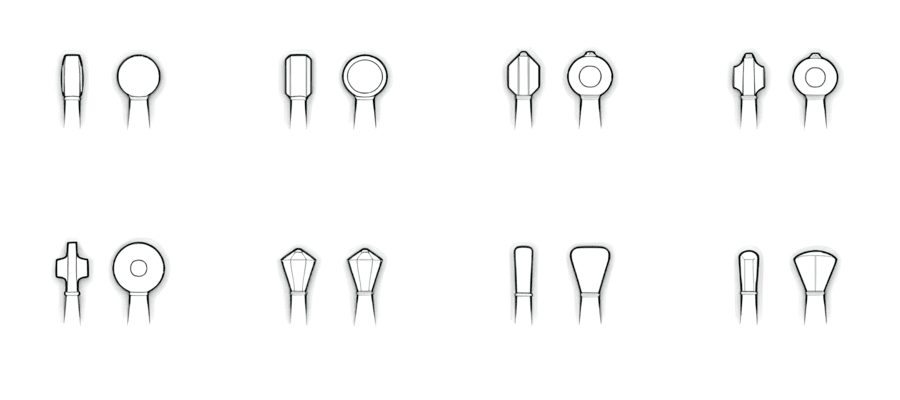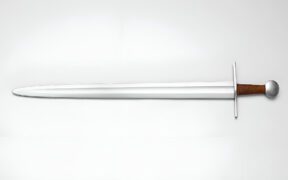Oakeshott Type XX: The Massive Sword From the Late Middle Ages
NO AI USED This Article has been written and edited by our team with no help of the AI

The Oakeshott type XX is the eleventh European double-edged sword from the Late Middle Ages through the beginning of the Renaissance. It was a sword that went through significant alternations as swordsmiths tried to balance various needs, such as being useful both on the battlefield and in tournaments.
Ewart Oakeshott was the leading researcher on European double-edged swords that spanned the Late Viking Age through the Renaissance. He researched swords for over half a century and developed a typology known today as the Oakeshott Typology. It consists of 13 parent types and minor sub-types to help classify these similar yet different weapons of war.
This article will focus on the Oakeshott type XX sword, starting with the characteristics that set them apart from other Oakeshott types. Then, we will explore its variety and sub-type and explain how they were best used. We will conclude the article by delving into the sword’s history and presenting some antique examples.
Characteristics of Type XX Swords

Many swords inside the Oakeshott Typology had specific features that set them apart. The type XX is especially interesting as it can share many traits of previous swords, except for a few key characteristics that Oakeshott felt put them in a separate sword group.
Sometimes, these swords can be hard to classify, and some modern sword typologists or enthusiasts have differing views on some of the sword examples by personal identification. Oakeshott originally classifies a type XVII in an early rendition manuscript, only to change it to a type XX in a later edition because of how similar they could look.
Blade

The blade of the Oakeshott type XX is double-edged, large, and broad. Its profile can be lenticular, hexagonal, or octagonal, with a gradual taper near the tip. What sets it apart from other similar Oakeshott type blades are its fullers. Type XX swords have three fullers that extend about half, 1/3, or 1/4 of the blade and sometimes feature a ricasso.
The first central fuller is longer in design, followed by two more shallow and shorter fullers on each side. Some XX blades have two fullers that are equally as long and extend a short way down the blade. The blade’s tip could be fairly acute or taper to a rounded point, similar to those of early-type XIII swords. The tang underneath the blade is rectangular and ends with a larger pommel.
Hilt (Guard and Pommel)

A type XX sword is in the fashion of a larger war sword with a lengthy hilt that can allow it to be wielded with both hands. Its center has a bulge, and the lower half is usually thinner. The crossguard is fairly long while extending on each side and can be straight in design. In most cases, the crossguard has a broad, flat section curved toward the blade at the quillons or, in a later, more complex style, with the terminals rolled over with a pronounced culp.
There was a wide variety of pommels that could vary in their design. Some of the most frequent was a scent stopper pommel that could be easily gripped with a hand, a larger rounded pommel disc-shaped with a convex, or flat-faced and thin or with chamfered edges.
Size and Weight

Oakeshott type XX swords could vary drastically in their weight depending on whether they would be used on the battlefields for effective cutting, in tournaments for dueling, or as bearing swords not intended for battle. Being larger in design also made them slightly heavier, weighing from three to 4.4 lbs (1.3 to 2 kg).
This sword sometimes resembles the later great swords due to its larger proportions when meant to be used as a primary weapon. The blade length of type XX was between 30 to 42 inches (76 to 107 cm), with some bearing swords reaching the 50-inch mark (127 cm). Its sizable hilt was between six and ten inches (15 to 25 cm) long, and its overall size was around 45 inches (114 cm) long.
Sub-type XXa

The type XX was seen as unique by Oakeshott in his first typology from 1958, which consisted of many different swords. With more research and blade distinction over the years, he created a sub-type called XXa and further types XXI and XXII, which were once part of the parent XX.
The main trait that makes this sub-type independent is the blade tapering. This taper can be gradual throughout the entire length of the blade. However, the blades that taper acutely toward the tip were more frequent. The hilt design, the number of fullers, and their characteristics were generally the same.
This sub-type XXa can be difficult to distinguish from others. In his later updated typology, Oakeshott refers to this sword as a one-handed or hand-and-a-half type. Its blade could be smaller, ranging from 22 to 34 inches (56 to 86 cm).
Uses of Type XX Swords

Oakeshott type XX swords were large, bladed-edged weapons primarily intended to be used with both hands. These two-handed blades were effectively used for chopping and cutting due to the more rounded blade tip and broader design, similar to earlier cutting Oakeshott types.
This blade design was effective for cutting attacks because, during the time, plate armor was becoming less significant due to the increased effectiveness and impact of long projectile weapons, especially in the later years of the sword. Its sub-type XXa was a more versatile sword that was an effective offense against enemies on the battlefield due to its more tapered blade.
Some larger type XX swords could be used in tournaments as longswords for dueling or as ceremonial and decorative bearing swords. These would generally be carried during parades to demonstrate the status or wealth of its owner.
History and Historical Examples of Type XX Swords

The type XX swords classified by Oakeshott were some of the largest longswords used at the end of the Late Middle Ages and the beginning of the Renaissance. They were very popular swords in Western Europe and Germany, with some antique blades having Passau or Solingen wolf marks, a trademark of the armor’s guild dating back to the 13th century.

These XX blades were similar in fashion to some previous cutting-oriented swords. This style of cutting swords could have returned due to the decline in the value of the plate armor on the battlefield. Although highly armored units were still in practice, the need for a larger cutter may have been useful because some plate pieces were being removed, especially at the arms and legs.

With the end of the medieval era and the beginning of the Renaissance, blades were starting to change in how their fuller configuration was set up. This was especially the case in the larger blades, such as the XX and XXa, which set them apart from previous blades. Although this is the primary distinction explained by Oakeshott, type XX swords could sometimes fall into other categories as well.

These swords represent the final experimentation with two-handed swords of medieval times. There aren’t a lot of antique examples, and further study is required to better understand them, which makes them fall in the gray area of some other sword types. Despite that, type XX swords had their own qualities, which would be passed down to the later European swords.





